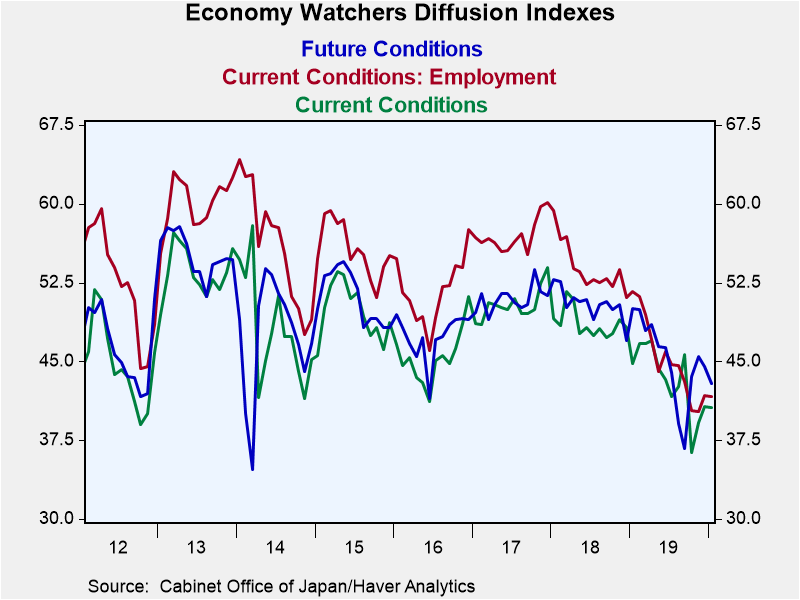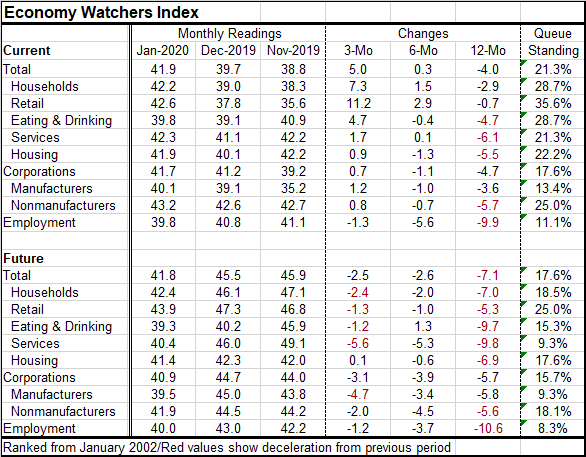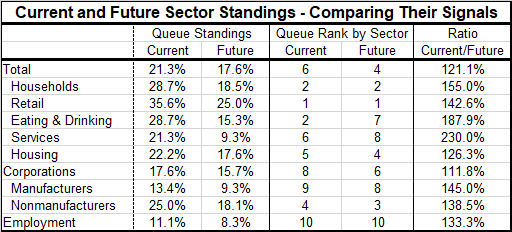 Global| Feb 10 2020
Global| Feb 10 2020Japan's Economy Watchers Index Offers a Split Decision
Summary
The economy watchers index is at odds with itself this month and recently. The current index rose to 41.9 in January from 39.7 in December, its third month-to-month improvement in a row. But the future index fell to 41.8 in January [...]
 The economy watchers index is at odds with itself this month and recently. The current index rose to 41.9 in January from 39.7 in December, its third month-to-month improvement in a row. But the future index fell to 41.8 in January from 45.5 in December, its second drop in a row.
The economy watchers index is at odds with itself this month and recently. The current index rose to 41.9 in January from 39.7 in December, its third month-to-month improvement in a row. But the future index fell to 41.8 in January from 45.5 in December, its second drop in a row.
Beyond the month-to-month divergences, there are divergences that have developed over three months. All the current index categories are stronger over three months except for employment. This contrasts with the future index where all categories except housing are contracting over three months. Over six months, the current index is rising while the future index is falling, further deepening the split view. But over six months, all future components except one are falling. The current index over six months shows six categories falling and three categories rising, but rising by enough to push the headline higher over six months. Over 12 months, both the current and future index are lower on balance with the future index falling by more.

The queue standings complicate comparisons. On one hand, both indexes have low queue standings in January. Remember that queue standings have their median at a 50 percentile rankings so all of these ranking are well below their respective medians (see Table below). Yet, the path and pattern of recent changes is different for the current and future readings. The queue standings of each of the current categories is higher than for the same future category (far right-hand column values all exceed 100%). Yet, the ranking structure of the queue standings for the current situation categories is highly similar to the ranking structure in the future index categories despite the differences in rankings themselves. In fact, the only sector that is not behaving ‘about the same' in both the current and future habitats ranking is eating and drinking places that have a relatively stronger current ranking and relatively much weaker future ranking (a ‘2' ranking vs. a ‘7' ranking). For both the current and the future indexes, employment has the weakest queue standing.

These, of course, are assessments for early in the year and the current sector performance clearly has not have been affected that much by the coronavirus scare. The next reading should give us a better view of the impact of the virus on economic performance. As for expectations, they may be the reason for the growing split between the current and future queue standings. Over the last 100 months the month-to-month change in the current index ranks as the 10th best. But the future index drop has only been larger only four times in the past. The discrepancy between the future and current rankings of changes has been greater than January's drop only 3 times in the past 100 months, but two of those came in September and October of last year before the virus was known (reports suggest that the virus was known in China in December).
Because of these earlier substantial divergences, it is hard to say that the current split decision on the ranking of the current and future indexes can be laid at the feet of the virus (if a virus can be said to have feet…). Prior to the virus, there have been trade war impacts in place that have been a severe issue for Japan. All this simply outlines the various pressures that Japan is feeling. The U.S.-China trade war caught Japan up in its collateral damage; now so is the coronavirus as Japan does so much business with China, has factories there and also has substantial travel and other economic linkages.
The current and future indexes have highly similar queue standings overall and (as the graph shows) both had been following a broadly similar path lower even though their recent three-month and six- month paths have been different. It is in this recent period when, after a long cycle of decay, when both indexes had begun to bounce from their lowest recent readings late in 2019 that degree of bounce has been quite different. The future index may in fact be on the cusp of giving its bounce back.
A great deal for Japan depends on China getting this virus in order and contained fast. Looking farther ahead, Japan is set to host the summer Olympics and there is a great deal of concern about making Japan safe by then. The summer is a long way off, but then China is also a long way from containing the virus. Significantly, WHO chief Tedros Adhanom Ghebreyesus has said there have been “concerning instances” of transmission of the virus from people who had not been to China. “The detection of a small number of cases may indicate more widespread transmission in other countries; in short, we may only be seeing the tip of the iceberg,” he said in Geneva. That assessment certainly is chilling.
Robert Brusca
AuthorMore in Author Profile »Robert A. Brusca is Chief Economist of Fact and Opinion Economics, a consulting firm he founded in Manhattan. He has been an economist on Wall Street for over 25 years. He has visited central banking and large institutional clients in over 30 countries in his career as an economist. Mr. Brusca was a Divisional Research Chief at the Federal Reserve Bank of NY (Chief of the International Financial markets Division), a Fed Watcher at Irving Trust and Chief Economist at Nikko Securities International. He is widely quoted and appears in various media. Mr. Brusca holds an MA and Ph.D. in economics from Michigan State University and a BA in Economics from the University of Michigan. His research pursues his strong interests in non aligned policy economics as well as international economics. FAO Economics’ research targets investors to assist them in making better investment decisions in stocks, bonds and in a variety of international assets. The company does not manage money and has no conflicts in giving economic advice.






